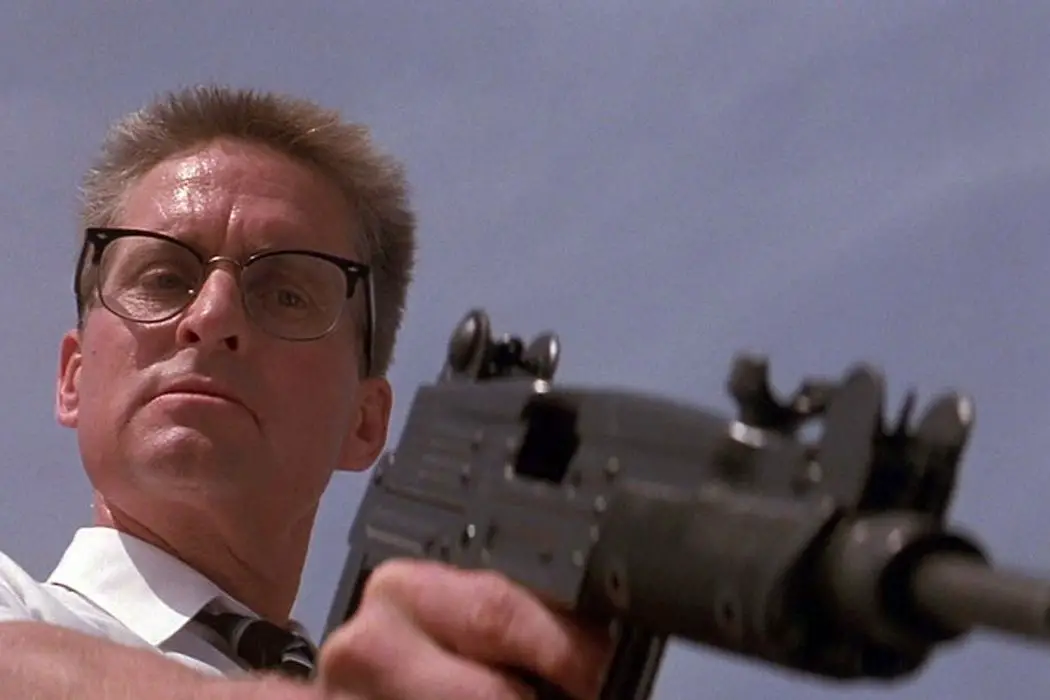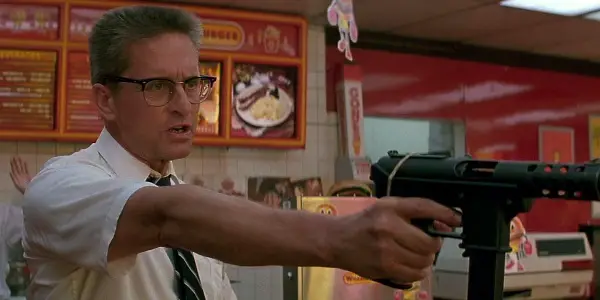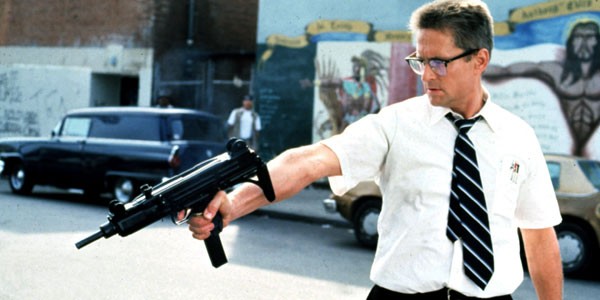FALLING DOWN’s Mental Breakdown Structured As Video Game Levels

Zac Hestand earned a BA in Film from the University…
Last year, Film Inquiry published an article titled “Did the Warriors Influence Video Game Structure?” on the basis of the film’s story structure that shows how each neighborhood represents a new game level with increased difficulty. The 1980s and ’90s saw the rise of the Nintendo and various game series, all with levels and tasks that grow increasingly difficult the more your game avatar advances. The 1993 film Falling Down followed, perhaps unintentionally, a video game format with its screenplay structure.
William Foster a.k.a. D-Fens (Michael Douglas) is a recently laid off defense worker stuck in traffic. The traffic is packed, and the increased heat only makes the situation more unbearable. When his air conditioner breaks, he’s had enough. He exits his car, and begins his journey home on foot through the streets of Los Angeles. Throughout his journey, he is faced with copious obstacles and slowly descends into madness.
Like The Warriors, the screenplay for Falling Down gives us a character presented with a problem and must go through a series of levels to reach the end of the game (home). With the case of the latter film, the levels presented not only contain physical obstacles, but psychological obstacles too. D-Fens is angry at contemporary American society, and his own life, lashing out over certain issues with increased anger and weaponry (his power-up tools).
Level One: Thirst
In video games, many levels require the gamer to collect a token of some sort to add power or bars to your lifeline. As stated earlier, the character faces obstacles in order to collect the token.

The mini-mart scene has our character in need of a soda to satisfy his thirst. He does not want to pay for the high price of Coke, so has his first mental breakdown. His obstacle is higher priced goods, and his weapon to fight is a baseball bat he steals from the clerk. D-Fens vandalizes the store, threatens the owner and ends the scene paying for his soda based on 1960s prices.
He added bars to his lifeline with the soda, and is able to continue on to the next level. Unfortunately, with all games, an attack decreases bars. For D-Fens, the hole in his shoe is his power drainer, causing him to slow down his walking.
Level Two: Weapons Upgrade
As the levels increase in games, the difficulties go up as well. Your avatar must go through the level faster, enemies are more powerful and achieving points becomes more difficult. Once D-Fens leaves the mini-mart, his journey becomes more challenging.
He gets harassed by a gang while resting. The breakdown continues with his commentary that hints at segregation and this causes one member to pull a switchblade. D-Fens attacks the gang with the bat, and gets the knife, a weapon upgrade. The gang tracks him down later, get in an accident, and D-Fens upgrades again from a knife to a gun.
In shooting games, the shooter is able to upgrade his or her artillery the more they are on the offense. As a shooter, when D-Fens lashes out over things due to his inability to control his mental decay, he is able to add stronger weapons each time. Unfortunately, with the hole still in his shoe and his energy decreasing, the character needs fuel. Like a game avatar, he must continue to boost his bars.
Level Three: Refuel and Reload
D-Fens refuels at a local fast food restaurant. He wants breakfast, but the obstacle is that the restaurant now serves lunch, even though it is just five minutes past the start time of the lunch menu. His breakdown continues with being unable to accept the news, and he pulls a gun on the workers and the whole restaurant. (*Given the recent US mass shootings in the news, this scene might be too disturbing for some viewers.*)

After using the fast food to add more to his life bars, he goes to an Army Surplus store to get new boots. At the store, the character gets a weapons upgrade from a gun to a rocket launcher. His obstacle is the white supremacist store owner who is more mentally unhinged than he is, and must fight him for the rocket launcher.
D-Fens continues to advance in levels through this video game structured screenplay. Like a game, whenever he feels weak, he finds an item to give him a boost. His mental status gives him the power to get through each level, becoming more dangerous through the progression of the story. He now has enough fuel and weaponry to reach the final level.
Level Four: The Last Level
Regardless of how many levels/worlds are in a game, the final level is the most challenging and is where the player fights the end level boss. The final level of Falling Down is the neighborhood of D-Fens’ ex-wife and daughter. He has now reached the end level, but like the previous ones, obstacles stand in his way.

Police Detective Prendergast (Robert Duvall) has been on the trail of D-Fens for most of the film, and faces him toward the end as our end level boss (Prendergast is the true hero of the movie, but here he is the obstacle in terms of video game structure). Prendergast tries to rescue the woman and child from the mentally unstable D-Fens.
Not a spoiler since this is a 25 year old movie, but D-Fens is killed at the end of the movie. Our game avatar is killed by the game boss, and does not meet his objective (to the complete relief of his ex-wife). As he dies at the end of the movie, it’s the conclusion of the story. In video game terms, it’s game over.
Final Thoughts
Falling Down continues to show viewers that video games and movies go hand-in-hand with each other. Screenplays involve characters that have problems, who try to solve the problem and the result is successful or unsuccessful. With games, your avatar has a problem and the gamer must try to solve it and the result is either beating the game or a game over.
The film was released several months before the first actual video game movie, Super Mario Bros., the latter being less successful. As of this reading, no video game adaptation achieved the cult status of The Warriors or sparks politically-charged debate like Falling Down. The answer is simple: stop with the video game adaptations. Use original ideas, and apply the video game structure to the screenplay. Video games themselves lack the drama of movies, so as with the case of Falling Down, merge them together. The result is a wonderful thing.
For more information about this movie, click here.
Do you agree with the above article? What other films are structured like video games? Please comment below.
Does content like this matter to you?
Become a Member and support film journalism. Unlock access to all of Film Inquiry`s great articles. Join a community of like-minded readers who are passionate about cinema - get access to our private members Network, give back to independent filmmakers, and more.
Zac Hestand earned a BA in Film from the University of Nevada Las Vegas, and MA in English from the University of Sheffield. He is currently at work on his first book.













